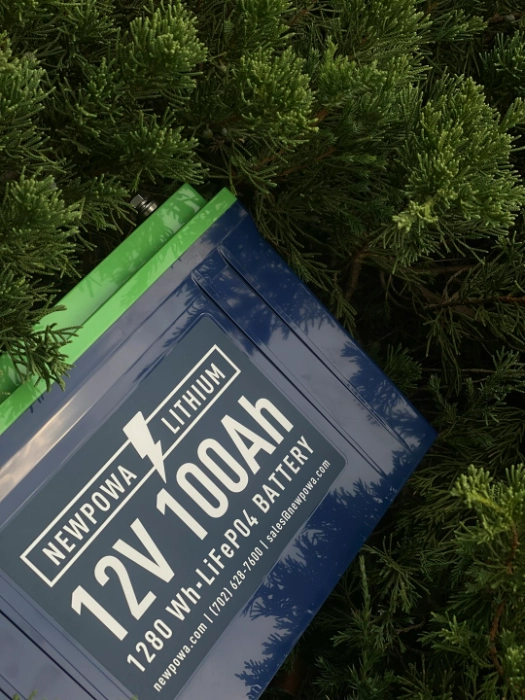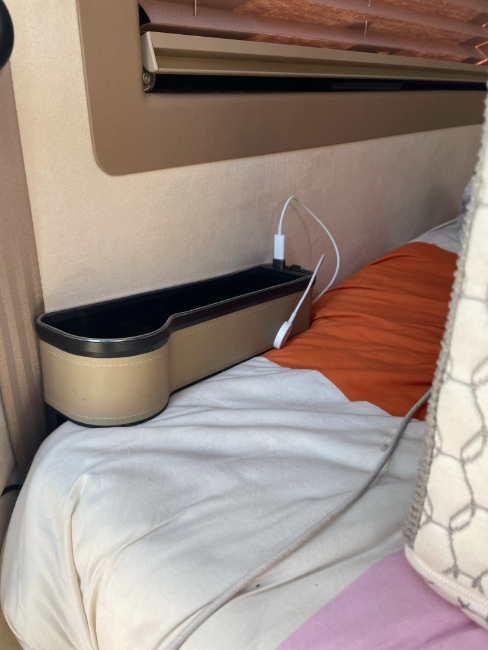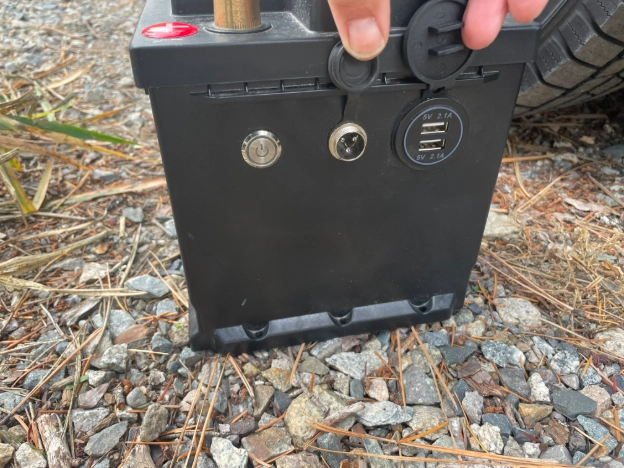LiFePO4 Lithium Battery That Pays For Itself

Disclosure: Some of the links in this article may be affiliate links, which can provide compensation to me at no cost to you if you decide to purchase. This site is not intended to provide financial advice and is for entertainment only.
When I switched to a LiFePO4 lithium battery, I didn’t just upgrade my power—I upgraded my entire van life. I bought my first Kepworth 12.8V 100Ah LiFePO4 in 2023, and it changed how I live off-grid. By 2024, I bought a second one. The freedom, reliability, and convenience this setup gives me has more than paid for itself.
If you’re building or upgrading your electrical system, this post covers what this battery is, why lithium is better than lead acid, how I converted my van to work with it, and why I’ll never go back.
What Is a LiFePO4 Lithium Battery?
A LiFePO4 lithium battery (that’s lithium iron phosphate for the techies) is the smarter, safer, longer-lasting replacement for the lead acid or AGM batteries that come standard in most RVs and vans.
The difference is chemistry. Lithium iron phosphate delivers consistent power and can discharge much deeper without damage. That means you get nearly 100% of its rated energy instead of only half like you do with lead acid.
When I first started learning about power systems during my early travels, I had no idea how much of a difference a good battery would make. I talk more about what it’s really like starting out on the road in Van Life for Beginners. Once I made the switch, my diesel heater, fantastic fan, and lights all ran smoother—and I stopped worrying about killing my batteries overnight.
Check the Kepworth pricing here:
Why Lithium Beats Lead Acid Every Time
Here’s why LiFePO4 technology is the new standard for anyone serious about off-grid living:
4,000+ charge cycles compared to 300–800 from lead acid
Lightweight (huge deal when every pound counts)
Fast charging from solar, alternator, or wall plug
No maintenance or acid leaks to babysit
Stable voltage until the battery is almost empty
In other words, it just works—and keeps working. When I first switched, I was still running the rest of my system off lead acid. Once I experienced how efficient lithium is, I rebuilt my setup from the ground up.
If you’re doing the same, my post on RV Repair School walks through what to watch for when rewiring or replacing old gear to handle lithium power safely.
Converting My Van to Work With Lithium Power
If your camperized van came wired for lead acid, you can’t just drop in a LiFePO4 and call it good. I added solar panels, a DC-DC charger that charges while the engine runs, and wiring rated for higher voltage.
I chose not to install a large inverter because I rarely need to run big AC appliances. For low-draw items like my Starlink router or TV, a small inverter does the trick. Most of the time I just plug directly into the battery’s built-in USB ports—one of the features I like most about the Kepworth model.
Those side USB ports pair perfectly with my four-way USB splitter (photo + Amazon link below), which powers my laptop, phone, rechargeable light, and fan all at once. No inverter, no noise, no wasted power.
And since space in any van is limited, I added a car cupholder with dual USB ports and a soft blue light. It sits next to my bed and doubles as a nightstand. It’s one of those simple accessories that makes life in a small space easier. I’ll include a photo and Amazon link below for anyone who wants to steal that idea.
LiFePO4 Lithium Battery Features and Specs
The Kepworth 12.8V 100Ah LiFePO4 is built for real-world use—RV, marine, or solar. Here’s what you get out of the box:
Dimensions: 13.07" L × 6.93" W × 8.66" H
Energy: 1,280 Wh
Weight: Light enough for one person to carry
Max Continuous Discharge: 100 A
Peak Inrush Current: 200 A for 3–5 seconds
Recommended Charge Voltage: 14.6 V
Recommended Charge Current: ≤ 50 A
Built in USB: 1The main reason I bought this, I like that I don't hav eto 4.6 V
Free 7 A Aviation-Head Charger: Included - major reason I bought this one.
The upgraded 100 A BMS (Battery Management System) protects against overcharge, over-discharge, short circuits, and extreme temperatures. That means it automatically cuts off charging when it’s too cold or too hot—essential for full-time van life in changing climates.
Kepworth uses Automotive-Grade A LiFePO4 cells, which provide consistent voltage and a 10-year expected lifespan. I’ve had zero issues with voltage sag or uneven charging across my two batteries.
Warranty, Support, and Sizing Options
Another reason I stick with Kepworth is their five-year after-service warranty and responsive support. If something goes wrong, they’ll provide a solution within 24 hours through Amazon’s “Contact Seller” option. That kind of follow-through is rare.
They also offer this battery in 50 Ah, 100 Ah, 200 Ah, and 400 Ah sizes, so you can build a bank that fits your setup. For anyone using it on a boat or in wet environments, I recommend a Group 31 waterproof battery box—it keeps things dry and secure.
This flexibility makes it ideal for RVs, camper vans, trolling motors, and even small off-grid cabins. If you are interested in a more portable battery bank check out my review of the Anker Solix F2000.
Why This Battery Pays For Itself
Between the long life, low maintenance, and rock-solid reliability, this LiFePO4 lithium battery truly pays for itself. After a year of daily use across two batteries, I’ve stopped worrying about power. No more lead-acid replacements, no more unexpected failures. Just steady, quiet energy that keeps my van running like home.
If you’re serious about going off-grid or upgrading your RV system, a LiFePO4 lithium battery isn’t just an investment—it’s freedom. And once you’ve lived with it, you’ll never go back.
FAQ
Can I Replace My RV Battery With a LiFePO4 Lithium Battery?
Yes — but not as a direct drop-in unless your system is already lithium-ready. Traditional RVs are usually wired for lead-acid or AGM batteries, which charge at lower voltages. A LiFePO4 lithium battery like the Kepworth model prefers a charging voltage of about 14.6 V, so you’ll want to confirm your converter/charger supports lithium profiles or install a DC-DC charger between your alternator and the battery. You may also need to disable any “equalize” mode, since LiFePO4 doesn’t use that feature. Once your system matches those specs, it’s a seamless upgrade — lighter, faster, and more efficient than what you had before.
Can I Use My Regular RV Battery Charger With LiFePO4?
Only if it’s rated for lithium charging. A regular multi-stage lead-acid charger won’t fully top off a LiFePO4 battery and could shorten its life. The Kepworth battery includes a free 7 A aviation-head charger that’s lithium-compatible right out of the box. If you charge from multiple sources (solar, alternator, or shore power), make sure each charger limits voltage to 14.6 V and current to 50 A or less. You can even charge from both the side port and top terminals at the same time for faster recovery, as long as you stay within those limits.
Do I Need an Inverter With a LiFePO4 Lithium Battery?
Only for 120 V household devices like a coffee maker, microwave, or hair dryer. Everything else — laptops, phones, fans, LED lights — can run directly from the 12 V system or the USB ports built into the Kepworth battery. That’s why I love this setup. In my van, I use a small, low-draw inverter for my Starlink and portable TV, but most of my charging happens through USB. It’s quieter, safer, and uses less energy.
Is a LiFePO4 Lithium Battery Safe for RV and Van Use?
Yes — it’s actually one of the safest lithium chemistries available. The Battery Management System (BMS) inside the Kepworth protects against over-charge, over-discharge, short circuits, and high/low temperatures. If conditions get too hot or cold, it automatically cuts off charging or discharging until it’s safe again. That’s a big upgrade from traditional batteries that can overheat, gas, or even crack in extreme weather. For anyone full-timing or boondocking year-round, that safety margin makes all the difference.
Affiliate Note
Some links above are affiliate links, meaning I may earn a small commission if you purchase through them—at no extra cost to you. Using those links helps support the free guides I share on MissadVANture.com.
Disclosure: Some of the links in this article may be affiliate links, which can provide compensation to me at no cost to you if you decide to purchase. This site is not intended to provide financial advice and is for entertainment only.


